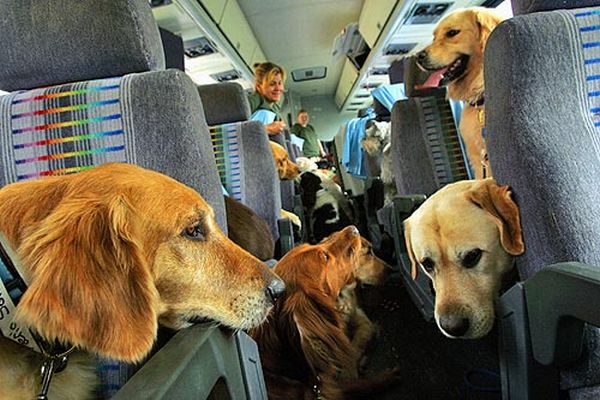If you plan to go on a trip with your pet, remember that airlines and buses have different rules for animal transportation that vary according to the company, destination, time of travel and pet’s characteristics.
On Aeromexico flights, for example, pets can travel in the cabin with other passengers or in the luggage compartment. It will depend on the type of airplane and the size of the pet, if it is authorized or not to go in the cabin.
But if the pet is not allowed to travel with its owner in the cabin, it must be documented as it was a piece of baggage, and it will have to make the trip in the baggage compartment, as long as it does not exceed 45 kilos (100 lbs), including the weight of the cage or transporter.
In any case, you must pay an additional fee for your pet, 1,000 Mexican pesos for domestic flights and 125 US Dollars for international flights.
Keep in mind that, according to the regulations of the airline, during the flight you will not be able to give food or water to your pet; in case of emergency, oxygen will not be provided, children will not be allowed to travel alone with pets, and puppies less than four months old and/or females with suckling pups will not be accepted.

If you travel in the cabin with your pet, you will be asked for veterinary and vaccination certificates against rabies issued no later than 30 days before the day of travel.
Because of the breathing problems they present during the flight and their high levels of stress, brachycephalic dogs and cats must travel in the cabin. Among them are Burmese, Himalayan and Persian cats, and dogs of the following breeds: Pug, Bulldog, Boston Terrier, Boxer, Chow Chow, lhasa apso, Maltese, Pekingese, Sharpei and Yorkshire Terrier.
Other animals, such as reptiles, fish and rodents, must travel in the luggage compartment.
If your pet is a guide dog for the blind or visually impaired, or another type of service animal, then the airline allows you to travel with it in the cabin at no extra charge. Animals for emotional support and psychiatric services are also exempt from payment, which in addition to dogs and cats, can be monkeys and pigs that do not exceed 9 kilos (20 lbs).
Each country establishes their own requirements for the admission of animals from abroad, which you will have to investigate before traveling to a particular destination.

In buses the conditions for the transfer of pets are different. In Mexico, the ADO regulations indicate all domestic animals travel in the luggage compartment, and only guide, official or rescue dogs are accepted on board the vehicles.
There is no additional charge if the weight of the animal is less than 25 kilos (55 lbs). The trip should not last more than eight hours. Animals are not accepted when the temperature exceeds 30 degrees Celsius at any point of the trip. Preferably the pet must be sedated.
Documents such as vaccination card, health and import certificates (where needed) are also requested.
The company allows the transfer of up to two pets per bus, which are admitted in the order in which the owners arrive.

Veterinaria Gabriela de Jesús Constantino Corzo (DY)
Veterinarian Gabriela de Jesús Constantino Corzo, specialist in Clinical Ethology by the UNAM, recommends that before traveling with a pet, factors such as the time of travel, the place where the animal will be placed, and the pet’s age should be taken into account. It’s also vital to know if the pet has a medical condition or physical or mental illness, if it’s under treatment or if you it it’s used to traveling.
To medicate or not the pet to face the trip is a decision that has to be taken by a Vet.
The expert indicates that it is advisable not to administrate tranquilizers or sedatives, because they could have adverse effects on the animal when combined with changes in altitude, pressure, temperature, dehydration or fasting.
There are veterinary medicines that are anxiolytic, panicolytic and antiemetic (against vomiting and nausea) and have different start times, duration, presentation and price.
The veterinarian suggests preparing the animal for the trip, accustoming it to the use of the transporter until it feels safe and comfortable insde it for a few hours, even on the move; first in short distances and then longer.
Also, depending on the trip duration and means of transportation, it is very important to hydrate the animal before the transfer, and preferably take its treats, toys, blankets and other control tools.
Source: http://yucatan.com.mx/



